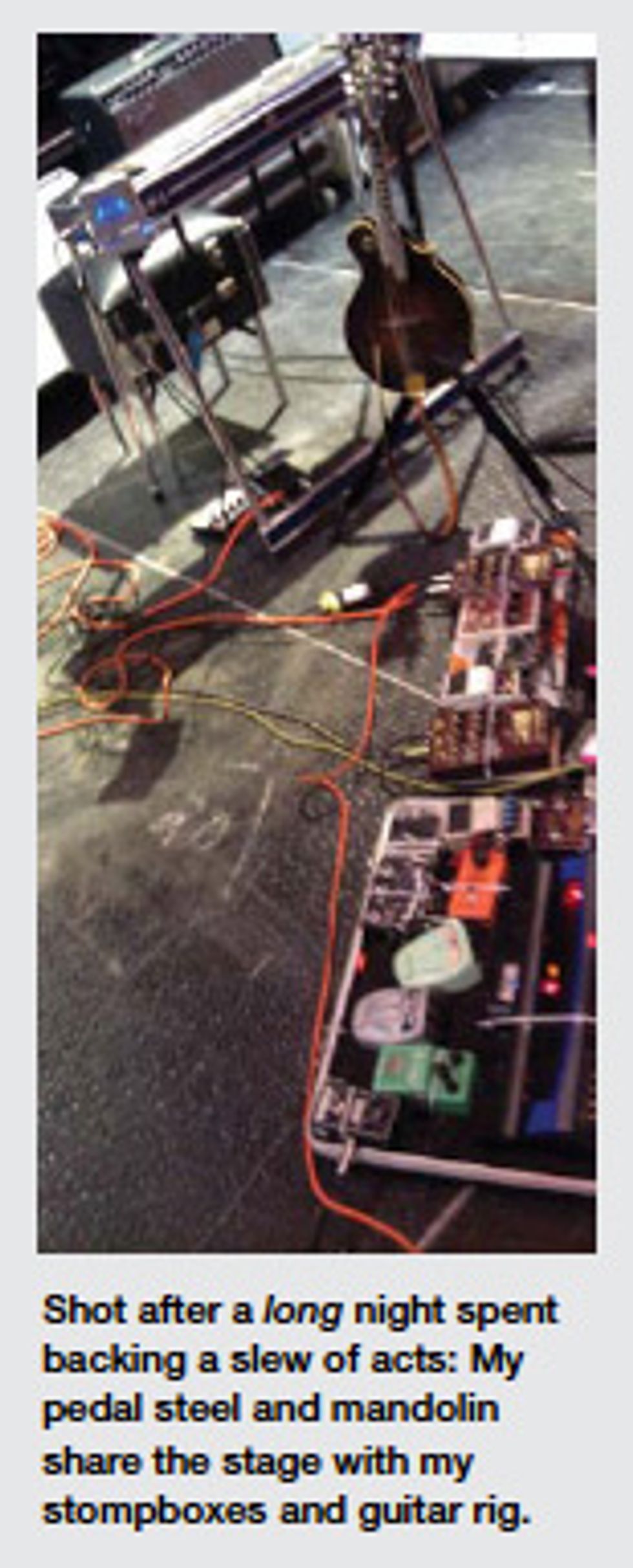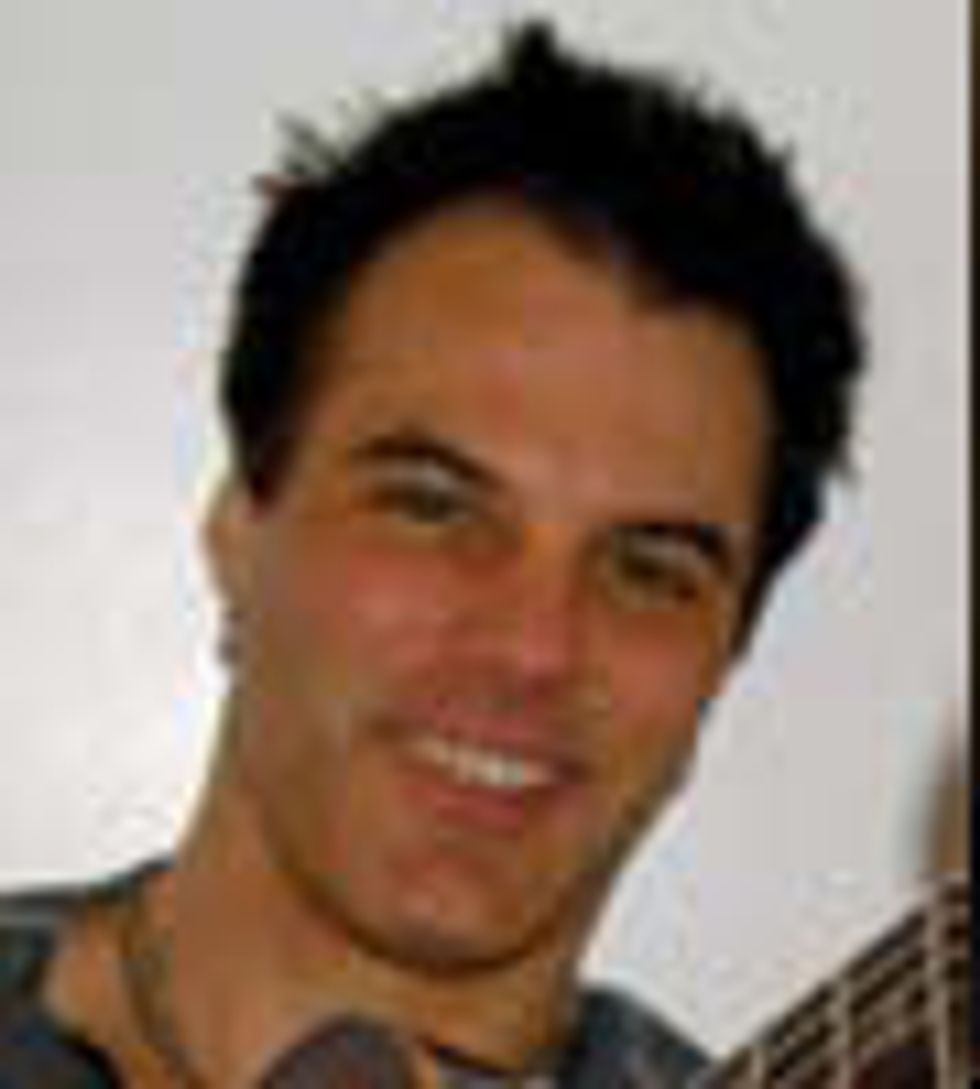When it comes to a career
in music, I plan on being
the last guy at the party—the
old dude who hangs around way
too long … the guy who everybody
wishes would just go home
or die so the rest of the good
citizens could get some sleep.
I'm a lifer intent on playing as
long as I'm breathing, even if it
means having a bag on my hip
and a tank of oxygen at my side
while I'm doing a weekly tour of
Elks, Eagles, American Legion,
and VFW clubs.
Rock guitarists do not age
gracefully. At best, there's
something comical—or at
worst, a little sad—about an
old guy rocking an Explorer
under a big gut, one unsure
foot creaking on the monitor
while the stage fan blows
through thinning dyed hair.
There are exceptions: Keith
and Ronnie, of course, will
always be cool. Jimmy Page
has successfully traded his sexy
rock god stature for a regal
presence, though his grey hair
makes him look a bit like
the Quaker Oat man. Steve
Cropper, though technically a
senior, looks like he could kick
my ass, and therefore remains
indelibly cool. Old black guys
always look cool with a guitar
in their hands. (Nobody
is ever going to tell B.B. or
Buddy they should consider
retiring.) However, I'm not
sure how well I'm going to
fare when those bitches we call
time and high mileage begin
to steal away my boyish good
looks. After giving this some
thought, I came to a realization:
I needed a Plan B.
That's one reason I started
playing pedal steel: Take an
ancient, hunched-over fat guy,
give him the requisite outfit—a Texas Taco cowboy hat, a
garish Western shirt with piping,
some baggy Wranglers
pulled up to his armpits—and
sit him behind a pedal steel,
and he will fit in on any stage.
I'm actually disappointed when
I see a guy under 50 on steel.
Mandolin, Dobro, and banjo,
though not quite as uncool as
steel, can also legitimize the
old man out there onstage.
Musical opportunities
grow exponentially with every
instrument one plays, so I've
picked up a few over the years.
Though electric guitar remains
my main squeeze, I also get
gigs for acoustic, Dobro,
mandolin, pedal steel, banjo,
bass, and blues harp. Though
I'm hardly an expert on any of
these instruments, I can sound
like I know what I'm doing
for a few songs on each instrument.
The truth is, most people
can't stand banjo, mando,
reso, or pedal steel for more
than a few songs anyway.
The utility thing really pays
off in the studio, where different
sonic colors can send
a track into an unexpectedly
beautiful and/or funky direction.
It may take me a few
extra passes than it would on
guitar, but eventually we'll
get there. It's particularly
nice when you get to sign the
“double" space on the union
card during a master session.
Producers and artists are happy
because doubling gets them the
flavor without the full expense
of bringing in another player,
and it turns a vanilla track into
something more exotic.
What were once considered
hillbilly instruments are now
accepted as “world music"
instruments. Listen to rock or
pop radio long enough, and
you'll hear mandolins, accordions,
pedal steels, etc. My wife,
Megan Mullins, actually played
banjo with Shakira. It doesn't
get more “world" than Shakira.
The multi-instrumentalist/
utility calling card has paid
great dividends. Two weeks
ago, Nashville guitar ace
Kenny Greenberg called me
for an amazing utility gig.
Kenny was the bandleader
for the Bama Rising concert,
where they would accompany
multiple acts. Kenny was handling
the lead guitar duties
but needed somebody to cover
Dobro, steel, banjo, mandolin,
acoustic, and electric guitar.
It was an amazing lineup of
diverse acts, including Sheryl
Crow (I played pedal steel and
mandolin), the Commodores
(electric), Sara Evans (mandolin
and electric), Little Big
Town (Dobro), Bo Bice (electric),
Ashton Shepherd (mandolin,
electric), Rodney Atkins
(banjo), Luke Bryant (banjo,
electric), and the Blind Boys of
Alabama (acoustic). If I didn't
have those instruments in my
bag of tricks, I would have
been stuck at home.
To a certain extent, being
the bandleader for a mid-level,
major-label artist is a bit like
coaching a AAA baseball team:
Your pitcher has a couple of
hot weeks and he's called up
to the majors. Similarly, your
bass player can end up leaving
mid-tour to work with Faith
Hill. A quick fix is to move a
few things around. Your second
guitarist covers bass, your
keyboard player handles some
of the guitar, etc. When I'm
putting bands together for new
touring acts, I always take that
into consideration. The goal
is to be ready for anything,
should somebody leave suddenly
two hours before showtime
in Cedar Rapids.
But guitar remains my go-to
instrument. If I don't pick it
up once a day I feel wrong,
whereas I can go for months
without picking up some other
instruments. In fact, I almost
have to re-learn them in the
studio or at the gig. But these
instruments have definitely
enriched my life and gotten
me more work. These may not
all be lucrative gigs, but fun
has always been my preferred
form of currency.
John Bohlinger is a Nashville multi-instrumentalist best know for his work in television, having lead the band for all six season of NBC's hit program Nashville Star, the 2011, 2010 and 2009 CMT Music Awards, as well as many specials for GAC, PBS, CMT, USA and HDTV.
John's music compositions and playing can be heard in several major label albums, motion pictures, over one hundred television spots and Muzak... (yes, Muzak does play some cool stuff.) Visit him at youtube.com/user/johnbohlinger
or facebook.com/johnbohlinger and check out his new band, The Tennessee Hot Damns.
















![Rig Rundown: Russian Circles’ Mike Sullivan [2025]](https://www.premierguitar.com/media-library/youtube.jpg?id=62303631&width=1245&height=700&quality=70&coordinates=0%2C0%2C0%2C0)




